Gladiolus phoenix
Gladiolus phoenix Goldblatt & J.C.Manning
Family: Iridaceae
Common names: ash lady (Eng.)
Introduction
A Critically Rare, highly localized endemic from the Bain’s Kloof Mountains. It produces bright pink flowers only in the first year after a fire, the plants growing in the ashes among the burned remains of other plants. It is an incredibly poorly known species with very limited available literature.

Description
Description
This species is a deciduous cormous geophyte that is rarely evergreen and grows up to a height of 500-750 mm. The corm is globose, approximately 8-12 mm in diameter and bears clusters of small cormlets around the base, on short stolons. The stem is erect and typically has between one and three branches. A plant produces 6 to 9 leaves, with an additional leaf per branch, and the lower 3 to 5 are basal leaves, reaching the base of the spike. The leaves are 6-12 mm wide and are narrowly lanceolate to linear. The leaf midrib and secondary veins are strongly raised and the lowest leaves are the longest ones. They also have specialized, reduced leaves called cataphylls, which are green and grow up to 80 mm above ground level. The bracts (specialized leaf-like structures on the flower spike) are about 15 mm wide, dark green and are lightly folded in the midline.
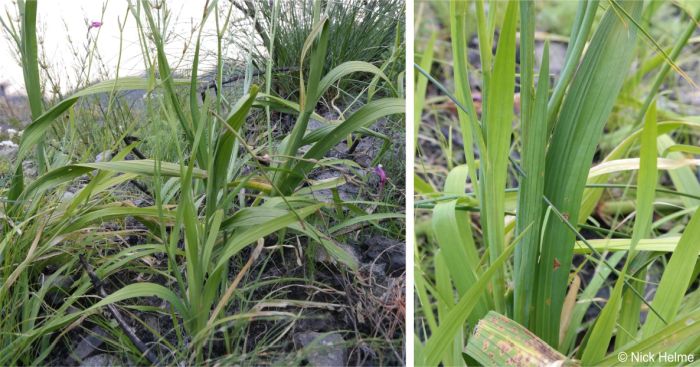
Gladiolus phoenix produces deep pink flowers with the lower three tepals displaying a white, spear-shaped mark in the midline, outlined in deep pink. It has a funnel-shaped perianth tube which is 18-20 mm long. The capsules are 12–15 mm long, 3-lobed, narrowly ovoid and the seeds are 8 x 5 mm and are broadly and evenly winged. Flowering occurs in early summer, between November and early December and only takes place after fires.
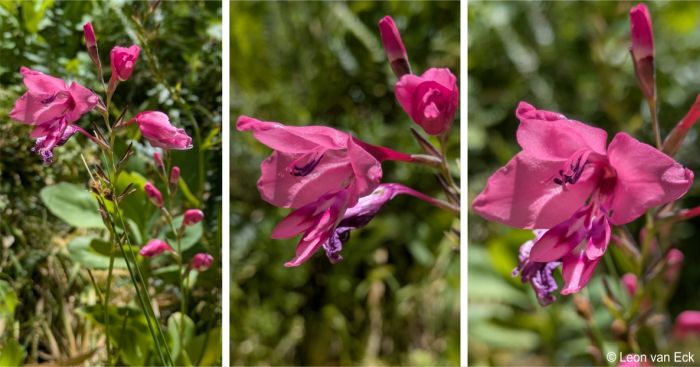
It is unlikely to be confused with any other species due to its highly localized distribution. Its closest relatives G. oreocharis and G. crispulatus also produce pink flowers with white markings on the lower tepals and flower in late spring or summer. Gladiolus phoenix can be distinguished from these two as it is more robust and has broad, nearly ribbed leaves. Its flower spikes are elongated with up to 4 branches which have many flowers per branch.
Conservation Status
Status
The Red List of South African Plants classifies Gladiolus phoenix as Critically Rare. This means that the species is known from only a single site, with no current threats. However, illegal harvesting has become a potential threat due to the rarity of this species and its attractive flowers.
Distribution and habitat
Distribution description
Gladiolus phoenix is restricted to a small area in the Bain’s Kloof Mountains above Wellington in the Western Cape Province, South Africa. Plants grow on moist banks and ravines, often in light shade, in humus-rich, peaty soil. The vegetation type in this area is Hawequas Sandstone Fynbos, which is characterized by a mean annual precipitation (MAP) of 530–2140 mm which peaks from May to August. The mean daily maximum and minimum temperatures are 25.4°C and 4.4°C for February and July respectively. The frost incidence in this area is 3-20 days per year.
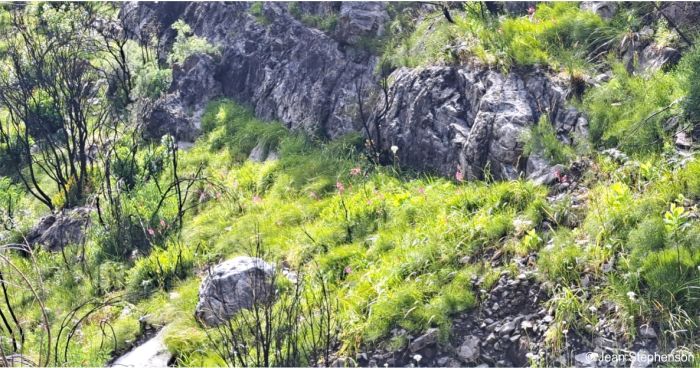
Derivation of name and historical aspects
History
The genus name Gladiolus is derived from the Latin diminutive of gladius which means ‘sword’ referring to the sword-shaped leaves. The specific epithet phoenix is interpreted as ‘rising from the ashes’ referring to its habit of flowering only after fire. This species’ common name ash lady also reflects its fire adaptation.
The genus Gladiolus belongs to the family Iridaceae, which includes approximately 70 genera and about 2160 species globally. In the southern African region, 36 genera and roughly 1210 species are represented in this family. These species are mostly concentrated in the winter-rainfall belt in the southwest of the region, with some occurring along the Drakensberg Escarpment of KwaZulu-Natal and Lesotho. The genus Gladiolus includes 169 species in southern Africa and is the second largest genus in the Iridaceae family in the region, after Moraea. Other genera in the southern African Iridaceae family include Geissorhiza, Ixia, Babiana and Hesperantha.
Ecology
Ecology
All gladioli are able to reproduce both sexually and vegetatively. Sexual reproduction occurs through pollination and seed production, while vegetative reproduction involves regeneration from the corm. While plants have both male and female reproductive organs, the species are self-incompatible and require cross-pollination for sexual reproduction. The primary pollinators include long-tongued apid and anthophorine bees, short-tongued halictid and andrenid bees, long-proboscid flies, hopliine beetles, sunbirds, moths and large butterflies. The primary pollinator for Gladiolus phoenix is Amegilla spilostoma, an anthophorine bee. Floral form correlates closely to the pollination strategy in southern African Gladiolus species, and seven distinct pollination systems have been identified which include: 1. Nectariferous bee flowers, 2. Pollen flowers, 3. Long-proboscid fly flowers, 4. Bird flowers, 5. Moth flowers, 6. Satyrid butterfly flowers and lastly, 7. Hopliine beetle flowers. Gladiolus phoenix belongs to nectariferous bee flowers group. Once gladioli flowers have been pollinated, they produce fruits called capsules. When these capsules dry out, they split open and seeds are dispersed. Most seeds are winged, and are dispersed by wind. Many gladioli, such as G. phoenix, flower prolifically following fires, particularly for winter rainfall species where intense flowering is observed in seasons post fire and starts diminishing thereafter. Gladiolus phoenix flowers only in the first year after fire.
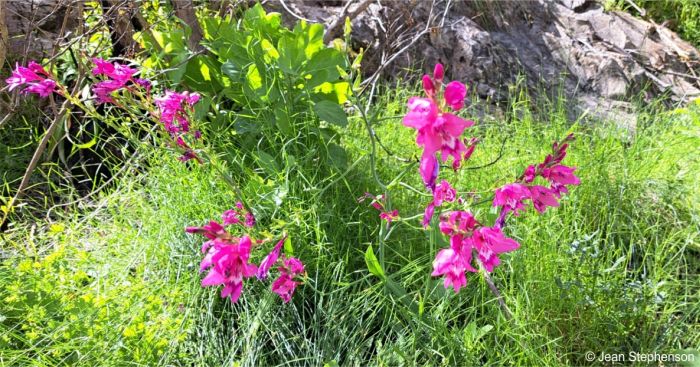
Uses
Use
There are currently no documented uses for Gladiolus phoenix, however the uses of other species in the genus have been reported. The corms of wild Gladiolus species have been used for many years by the Zulu and Sotho people of South Africa to treat dysentery, diarrhoea and other stomach ailments. Farmers are known to make an infusion of the corms and lower leaves to treat colds and coughs. A crushed Gladiolus flower can be used to soothe pain and stop bleeding from scratches. Certain species in this genus are also an important food source on the African continent. Furthermore, Gladiolus species have been popular horticultural subjects in Europe since the early 19th century and are important ornamentals in the cut flower trade. The wide variety of gladioli cultivated today is believed to have originated from the bright orange parrot flower, Gladiolus dalenii, which was taken to England from South Africa in the early 1700s. Gladioli rank fourth in the international trade after roses, carnations and chrysanthemums.
Growing Gladiolus phoenix
Grow
Gladiolus phoenix is a showy species but is difficult in cultivation, due to its specific habitat requirements and habit of sprouting and flowering only in the year after a fire and lying dormant in the soil between fires. These conditions are difficult to reproduce in a garden situation and it is thus not recommended as an ornamental garden plant.
Most species in this genus are not difficult to grow from seed and temperatures below 20°C are required for successful germination. Seeds should be sown in a well drained, sandy mix and covered well with this mix. After sowing, the planting pots should placed in water and allowed to soak thoroughly in water. This is because overhead watering can dislodge the seeds and cause them to float on the surface. Seed viability is best within the first year. Seedlings should only be transplanted after they have completed their second year of growth. Winter-growing species should be sown in autumn, and summer-growing species sown in spring.
Most commercially available gladioli plants can be planted in perennial beds and rock gardens or amongst shrubs. They grow best from the corm, the summer-growing varieties should be planted in spring and will flower in any sunny part in the garden. Winter-growing gladioli should be planted in autumn and are often better suited to containers where growing conditions can be controlled. Gladioli grow best in areas which receive between 6 and 8 hours of sun and bright light during the day. Gladioli grow best in well-drained, sandy soils, provided they receive sufficient water and nutrients. Good amounts of compost or peat moss should be added to the planting site. Gladioli corms should be placed in a trench that is 5-7 cm deep into the ground and spaced 10-15 cm apart, in loamy soil. After the corms have been planted, the soil should be moistened well with water. Good drainage is required, and some growers lay a trench with sand and set the corms into this, topping the sand off at the top of the corm. Young plants may require staking when the stalks are first produced to prevent wind damage. Most growers will cut the old stalks once the plant has flowered to preserve the plant’s energy for corm production. Gladiolus plants require light during the growing period and a light mulch can be added to maintain soil moisture. Growers can use a 6-6-6 fertiliser or any similar fertiliser, ensuring that label instructions are followed. They typically respond well to liquid fertiliser high in potassium applied when the flower spike starts to shoot. Gladiolus may be affected by caterpillars, grasshoppers and thrips. Pests can be handpicked from the plants and plants should be treated with pest-control products. In autumn, the corms should be dug up and stored in a frost-free area for the winter months.
The commercial cultivation of Gladiolus involves the natural multiplication of corms and cormels. The multiplication rate of corms is however too slow and faster methods such as dividing the corms, removal of leaf and flower spikes, use of standard corm size and mechanical removal of sprouts can help increase the multiplication rate of corms and cormels. These methods are however still insufficient to meet the demand and a number of in vitro protocols have been developed to regenerate Gladiolus plantlets.
References
- Cholo, F. & Raimondo, D. 2006. Gladiolus phoenix Goldblatt & J.C.Manning. National Assessment: Red List of South African Plants. http://redlist.sanbi.org/species.php?species=1549-491.
- Goldblatt, P. & Manning, J.C. 2020. Iridaceae of southern Africa. Strelitzia 42. South African National Biodiversity Institute, Pretoria.
- Goldblatt, P., Manning, J.C. & Bernhardt, P. 1998. Adaptive radiation of bee-pollinated Gladiolus species (Iridaceae) in southern Africa. Annals of the Missouri Botanical Garden 85: 492-517.
- Goldblatt, P., Manning, J.C. & Bernhardt, P. 2001. Radiation of pollination systems in Gladiolus (Iridaceae: Crocoideae) in southern Africa. Annals of the Missouri Botanical Garden 88: 713-734.
- Helme, N. 2015-Nov. Observation of Gladiolus phoenix, Bain’s Kloof. iNaturalist. Online. https://www.inaturalist.org/observations/11135132.
- MacCubbin, T. & Tasker, G. 2002. Florida gardener's guide. Cool Springs Press, Florida.
- Mattus, M. 2020. Mastering the art of flower gardening: a gardener's guide to growing flowers, from today's favorites to unusual varieties. Quarto Publishing group, Beverly.
- Memon, N.U.N., Wahocho, N.A., Miano, T.F. & Leghari, M.H. 2016. Propagation of Gladiolus corms and cormels: a review. African Journal of Biotechnology 32:1699-1710.
- Pacific Bulb Society. Gladiolus phoenix. https://www.pacificbulbsociety.org/pbswiki/index.php/Gladiolus_phoenix. Accessed 16/12/2024.
- Pacific Bulb Society. Gladiolus. https://www.pacificbulbsociety.org/pbswiki/index.php/Gladiolus. Accessed 16/12/2024.
- Roberts, M.J. 2000. Edible and medicinal flowers. New Africa Books, Cape Town.
- Saunders, R. & Saunders, R. 2021. Saunders’ field guide to gladioli of South Africa. Penguin Random House, South Africa.
- Siddiqui, M.W. 2018. Sustainable Horticulture, Volume 1: Diversity, Production, and Crop Improvement. Apple Academic Press, Oakville.
- Stephenson, J. 2024-Nov. Observation of Gladiolus phoenix, Bain’s Kloof. iNaturalist. Online. https://www.inaturalist.org/observations/250809384.
- Van Eck, L. 2024-Nov. Observation of Gladiolus phoenix, Bain’s Kloof. iNaturalist. Online. https://www.inaturalist.org/observations/252001185.
- Walker, S. 2024. How to grow flowers in small spaces: An illustrated guide to planning, planting and caring for your small space flower garden. Adams Media, New York.
- Wilford, R. 2019. The Kew gardener s guide to growing bulbs: The art and science to grow your own bulbs. White Lion Publishing, Kew.
Credits
Nokukhanya Nozipho Mhlongo
Threatened Species Programme
Pretoria National Herbarium
Biodiversity Research, Assessment and Monitoring Division
January 2025
Acknowledgments: images by Jean Stephenson, Nick Helme and Leon van Eck, from their observations posted on iNaturalist.
Plant Attributes:
Plant Type: Bulb
SA Distribution: Western Cape
Soil type: Sandy
Flowering season: Early Summer
PH: Acid
Flower colour: Pink
Aspect: Shade, Morning Sun (Semi Shade), Afternoon Sun (Semi Shade)
Gardening skill: Challenging
Special Features:
Horticultural zones
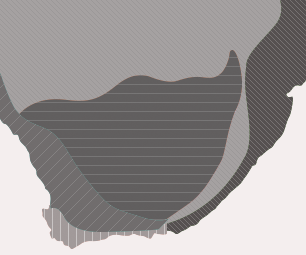







Rate this article
Article well written and informative
Rate this plant
Is this an interesting plant?
Login to add your Comment
Back to topNot registered yet? Click here to register.